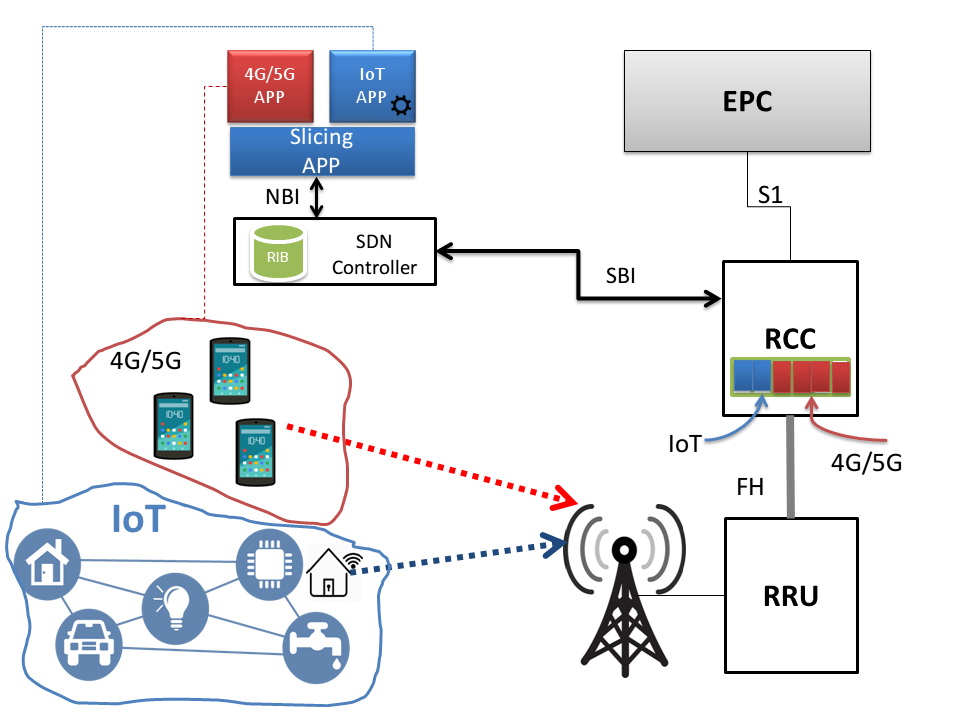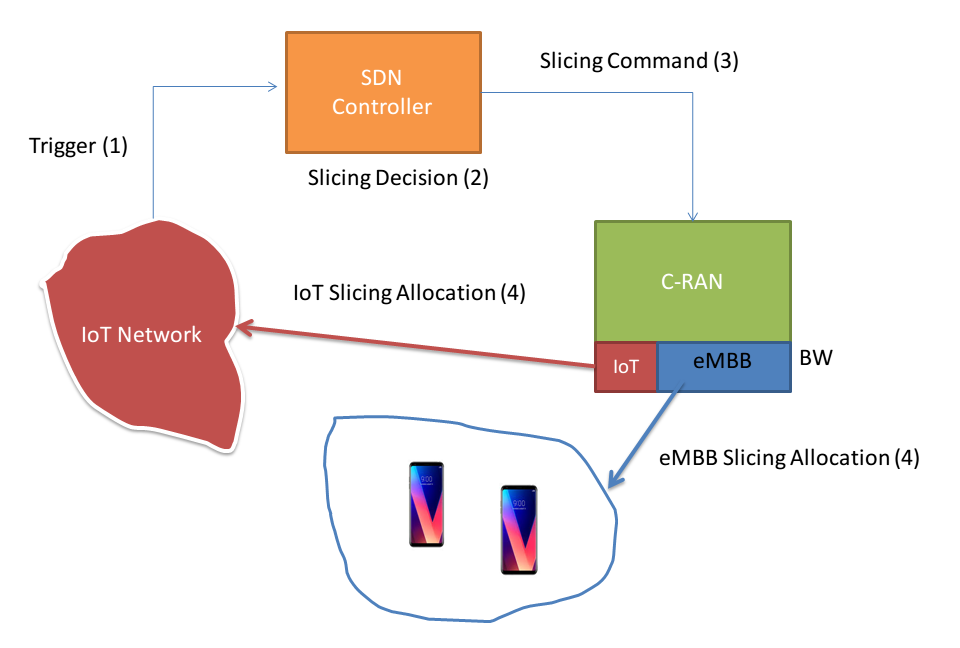C-RAN Network Slicing Prototype for IoT and eMBB services
Description:
Recent progress in sensor and communications have opened the road for the ever-growing development of Internet of Things (IoT) services, where a massive number of devices require access to the transport network, using widely deployed fixed or wireless access technologies and/or mobile Radio Access Network (RAN).
Supporting IoT in the RAN is challenging, as IoT services may generate a multitude of short and bursty sessions, thus impacting the performances of mobile users sharing the same RAN. To this end, network slicing is envisioned as a promising design approach to enable optimal support for heterogeneous service segments sharing the same RAN, i.e., the key requirement of the upcoming fifth generation (5G) mobile network.
In this work, we test a network slicing solution for enabling efficient coexistence of enhanced mobile broadband (eMBB) and IoT services, sharing the same RAN. Our solution aims at efficiently sharing the bandwidth resources among different slice segments, while considering their requirements
To this end, we have integrated our C-RAN Prototype with the Internet of Things (IoT) platorm BeC3 and validated the feasibility of the prototype in supporting the creation and configuration of network slices on-demand, taking into account diverse requirements that are elaborated by a northbound SDN-based slicing application.
By means of experiments, we show that the prototype is capable to dynamically manage the slicing process in real-time, providing isolation among eMBB and IoT services.
In the following video, we present a demo of our prototype. The aim of this demo is to show the feasibility of the prototype in handling the creation and configuration of IoT and eMBB slices on-demand, taking into account some inputs that are elaborated from an SDN northbound application.
REFERENCES
Recent progress in sensor and communications have opened the road for the ever-growing development of Internet of Things (IoT) services, where a massive number of devices require access to the transport network, using widely deployed fixed or wireless access technologies and/or mobile Radio Access Network (RAN).
Supporting IoT in the RAN is challenging, as IoT services may generate a multitude of short and bursty sessions, thus impacting the performances of mobile users sharing the same RAN. To this end, network slicing is envisioned as a promising design approach to enable optimal support for heterogeneous service segments sharing the same RAN, i.e., the key requirement of the upcoming fifth generation (5G) mobile network.
In this work, we test a network slicing solution for enabling efficient coexistence of enhanced mobile broadband (eMBB) and IoT services, sharing the same RAN. Our solution aims at efficiently sharing the bandwidth resources among different slice segments, while considering their requirements
To this end, we have integrated our C-RAN Prototype with the Internet of Things (IoT) platorm BeC3 and validated the feasibility of the prototype in supporting the creation and configuration of network slices on-demand, taking into account diverse requirements that are elaborated by a northbound SDN-based slicing application.
By means of experiments, we show that the prototype is capable to dynamically manage the slicing process in real-time, providing isolation among eMBB and IoT services.
Reference Scenario
The reference scenario studied in this work is depicted in Fig. 1.

Fig.1: Reference Scenario
We assume the presence of two type of devices: IoT nodes and mobile smart-phones:
Demo Goal:

The reference scenario studied in this work is depicted in Fig. 1.

Fig.1: Reference Scenario
We assume the presence of two type of devices: IoT nodes and mobile smart-phones:
- The IoT devices are connected to the RAN via a 4G gateway. The IoT gateway collects the IoT data periodically and establishes a connection with the C-RAN network when it needs to deliver the collected data to the cloud.
- The Mobile devices are equipped with a blank SIM, programmed according to the EPC-HSS database.
Demo Goal:
- Show integration of our C-RAN prototype with the IoT platform BeC3.
-
Show that the prototype is capable of enabling sharing
of the RAN resources among diverse services, i.e., IoT and eMBB slices
respectively.

Fig.2: Demo Scenario
DEMO Scenario:
- An Event at the IoT network Triggers the SDN Controller, which in turns reconfigures the slicing process in real-time
- Baseline Scenario: 1 slice for both IoT and eMBB services:
-
Upon a triggering event (IoT peak session/ IoT Alarm Event)
- A separated IoT slice is created in real-time:
- The IoT user moves to the IoT slice
- The Mobile user remains in the initial slice
- Upon another triggering event ( IoT Off-peak session/ IoT Alarm OFF)
- The IoT slice is destroyed
- The IoT traffic (low traffic load) and the eMBB traffic is handled by the same slice:
-More Bandwidth at disposal of the eMBB services during IoT Off-peak session
Demo:
C-RAN Network Slicing Prototype for IoT and eMBB services
In the following video, we present a demo of our prototype. The aim of this demo is to show the feasibility of the prototype in handling the creation and configuration of IoT and eMBB slices on-demand, taking into account some inputs that are elaborated from an SDN northbound application.
REFERENCES
- S. Costanzo, S.Cherrier and R. Langar, "Network Slicing Orchestration of IoT-BeC3 applications and eMBB services in C-RAN", IEEE International Conference on Computer Communications (INFOCOM) 2019, Paris, France, 29 April - 2 May 2019.
- S. Costanzo, I. Fajjari, N. Aitsaadi, and R. Langar, "Dynamic Network Slicing for 5G IoT and eMBB services: A New Design with Prototype and Implementation Results", IEEE Cloudification of the Internet of Things Conference (CIoT) 2018, Paris, France, 2-4 Jul. 2018.
- https://www.docker.com/
- USRP B200/B210 Specification Sheet, avalaible online at https://www.ettus.com/product/details/UB200-KIT
- X. Foukas, N. Nikaein, M. M. Kassem, M. K. Marina and K. Kontovasilis, FlexRAN: A Flexible and Programmable Platform for Software-Defined Radio Access Networks,ACM CoNEXT, California, USA, 12-15 Dec. 2016.
- https://sdr-lab.u-pem.fr/slicing-C-RAN.html
- S. Matoussi, I. Fajjari, S. Costanzo, N. Aitsaadi and R. Langar, "Joint Functional Split and Resource Allocation in 5G Cloud-RAN", IEEE International Conference on Communications (ICC) 2019, Shanghai, China, 20-24 May 2019.
- S. Matoussi, I. Fajjari, S. Costanzo, N. Aitsaadi and R. Langar, "A User Centric Virtual Network Function Orchestration for Agile 5G Cloud-RAN", IEEE International Conference on Communications (ICC) 2018, Kansas City, MO, USA, 20-24 May 2018.
- S. Costanzo, I. Fajjari, N. Aitsaadi and R. Langar, "A Network Slicing Prototype for a Flexible Cloud Radio Access Network", 15th IEEE Annual Consumer Communications Networking Conference (CCNC), Las Vegas, NV, USA, 12-15 Jan. 2018.
- S. Costanzo, I. Fajjari, N. Aitsaadi and R. Langar, "DEMO: SDN-based Network Slicing in C-RAN", 15th IEEE Annual Consumer Communications Networking Conference (CCNC), Las Vegas, NV, USA, 12-15 Jan. 2018.
